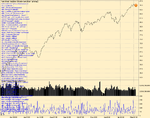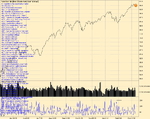One of the things I did to look at the effectiveness (or otherwise) of candle patterns was to plot a count of the number of stocks exhibiting bullish or bearish patterns against an index. An example is shown in the attached charts. The universe of stocks is the components of the SPX and benchmark is an unweighted arithmetic index of those stocks. My conclusion: inconclusive.
You are using an out of date browser. It may not display this or other websites correctly.
You should upgrade or use an alternative browser.
You should upgrade or use an alternative browser.
candlesticks not that important
- Thread starter Christiaan
- Start date
- Watchers 13
nine
Senior member
- Messages
- 2,038
- Likes
- 508
I suspect that many price patterns including those that form candles have poor results when taken without context. Similarly the context may have poor results without PA. But taken together the conclusion might be quite different ... but much harder to program.
I have found again and again that entry based on a single candlestick pattern and no other criteria will be only marginally better than random - key reversal, hammer, doji, whiplash, ID, etc.etc. Two other things are rerquired, firstly a corroborative signal/factor (that confirms direction and timing, suggesting an imminent move with sufficient energy to make entry worthwhile) and secondly an asymmetrical position management plan (such that all losers can only wipe out X pips but winners are always given opportunity to run to 1.5X or 2X or better).
I have found again and again that entry based on a single candlestick pattern and no other criteria will be only marginally better than random - key reversal, hammer, doji, whiplash, ID, etc.etc. Two other things are rerquired, firstly a corroborative signal/factor (that confirms direction and timing, suggesting an imminent move with sufficient energy to make entry worthwhile) and secondly an asymmetrical position management plan (such that all losers can only wipe out X pips but winners are always given opportunity to run to 1.5X or 2X or better).
I'm not sure how to judge an imminent move. In fact, I don't think that it is possible.
You can thinkthat a move is imminent which boils down to some of us being right and some of us wrong. The last part of your post, in brackets, is the key to all of it, IMO.
timsk
Legendary member
- Messages
- 8,596
- Likes
- 3,320
In the same vein - try Point & Figure.Try Renko Candles...you can determine the block size/points/pips.
In one fell swoop, all the angst and nail biting trying to interpret the 'meaning' (or lack thereof) of every candle is removed!
If the OP is still reading this and trying to decide whether or not to buy Nison's book, I'd offer this suggestion . . . It is a great book and beautifully produced but there's no point in getting it if candlesticks aren't your cup of tea. Better to decide first of all if TA floats your boat and then decide which aspect of it you wish to focus on. A very good and unbiased introduction to the subject is this one by Alistair Blair:
Investor's Guide to Charting: An Analysis for the Intelligent Investor
If you decide to go down the P&F route, then this is the book to get:
The Definitive Guide to Point and Figure
Tim.
Yes Split - I continue to learn about candlestick formations and chart patterns that are useful starting points though they do not reward like the Holy Grail, but the corroborative signals continue to elude. Maybe THEY are the true Holy Grail......
timsk
Legendary member
- Messages
- 8,596
- Likes
- 3,320
Split',I'm not sure how to judge an imminent move. In fact, I don't think that it is possible.
There are lots of ways to judge an imminent move - here's a couple;
1. For price action purists:
The Springboard
2. For indicator junkies (view the video):
TTM 'Squeeze' Indicator
Enjoy!
Tim.
I suspect that many price patterns including those that form candles have poor results when taken without context. Similarly the context may have poor results without PA. But taken together the conclusion might be quite different ... but much harder to program.
Good point. This is often true because most trade signals of patterns rather than probabilities of price moves arising from these patterns. There is a big difference in the two approaches. The former is the losing approach. The other is very hard to program and automate I agree.
Split',
There are lots of ways to judge an imminent move - here's a couple;
1. For price action purists:
The Springboard
2. For indicator junkies (view the video):
TTM 'Squeeze' Indicator
Enjoy!
Tim.
Sorry, Tim, springboards don't do it (I'll read the "squeeze" one later). What does it for me is sixth sense and the part of Tom's post that was in brackets ie. control of loss. A back article of T2W's said that loss is the only thing that a trader has control over. That is, probably, one of the statements I read that have made me a survivor at 78!
It's probably prevented me from lying under a palm tree on some tropical beach, too, but that is another story.
rathcoole_exile
Guest Author
- Messages
- 3,925
- Likes
- 767
Sorry, Tim, springboards don't do it (I'll read the "squeeze" one later). What does it for me is sixth sense and the part of Tom's post that was in brackets ie. control of loss. A back article of T2W's said that loss is the only thing that a trader has control over. That is, probably, one of the statements I read that have made me a survivor at 78!
It's probably prevented me from lying under a palm tree on some tropical beach, too, but that is another story.
Split, I hate to disagree with your venerable good self. However, I do feel that you have been too quick to dismiss the "Springboard".
You are absolutely correct that control of loss is important, vital.
But surely the ability to recognise when to stay out of the market and prepare oneself (perhaps with resting Stop Entry orders) is also a key element to successful trading and a valid 'position', that many newbies simply overlook ?
timsk
Legendary member
- Messages
- 8,596
- Likes
- 3,320
Hi Split',Sorry, Tim, springboards don't do it (I'll read the "squeeze" one later). What does it for me is sixth sense and the part of Tom's post that was in brackets ie. control of loss. A back article of T2W's said that loss is the only thing that a trader has control over. That is, probably, one of the statements I read that have made me a survivor at 78!
It's probably prevented me from lying under a palm tree on some tropical beach, too, but that is another story.
I accept fully that springboards don't cut the mustard for you personally but, as a signpost to an imminent move, they're pretty effective. I mention them purely as an example of how it is possible to judge an imminent move in advance of it happening. Of course, whether or not a trader can judge the direction of the move correctly and take advantage of the move when it occurs - is another matter entirely.
Tim.
rathcoole_exile
Guest Author
- Messages
- 3,925
- Likes
- 767
Hi Split',
whether or not a trader can judge the direction of the move correctly .
hmmmm, if only they could invent something like a , oh I dunno, say, a "Bracketed Order"
wouldn't that take the guess work away, and eliminate the need to "judge" ?
all that would be needed then is an effective MM strategy to manage the inevitable false breakouts and breakdowns that sometimes occur.
which, time and time again swings me back to the 'random entry' argument...but that's a story for another thread
timsk
Legendary member
- Messages
- 8,596
- Likes
- 3,320
Hi Garry,hmmmm, if only they could invent something like a , oh I dunno, say, a "Bracketed Order"
Yes, in principle, this is a tool which could, potentially, help to get around the problem. However, as you're doubtless only too aware, it rather depends on precisely where you place your bracketed OCO orders and, once one or other of them is filled, where their correlating stop loss and take profit orders are placed. There's a whole bunch of variables in there and one only has to be out by a tick or two to produce a net loss, break even or net profit. So, while the principle is all fine and dandy, the execution needs to be absolutely spot on and repeatedly so which ain't at all easy. Of course, if you know a way around al these issues - please share 'em. Now!
Tim.
Lord Flasheart
Legendary member
- Messages
- 9,826
- Likes
- 985
from what i can see most people use candlesticks.I started using bar charts and have never got round to changing. Anyway it doesnt really matter which you use,just like evrything else that can or cant work. Its all no use unless your head and R/R are in tune
Split',
There are lots of ways to judge an imminent move - here's a couple;
1. For price action purists:
The Springboard
2. For indicator junkies (view the video):
TTM 'Squeeze' Indicator
Enjoy!
Tim.
The "Squeeze" indicator. Enjoy?
All this stuff is sales claptrap.
FXTrend240
Well-known member
- Messages
- 292
- Likes
- 10
the squeeze is surprisingly not bad, within a week i made a decent mechanical system with it on GBPJPY along with other stuff. john carter made it popular and now everyone's using it...
god bless john
god bless john
rathcoole_exile
Guest Author
- Messages
- 3,925
- Likes
- 767
one only has to be out by a tick or two to produce a net loss, break even or net profit. So, while the principle is all fine and dandy, the execution needs to be absolutely spot on and repeatedly so which ain't at all easy.
Tim,
surely these caveats apply to ANY and ALL trades anyway ?
The Squeeze, or something similar, that keeps people out of a trade when price is going nowhere has to be a good thing ?
And by suggesting people bracket a trade, all I am suggesting is that it takes the directional guess-work out of the equation.
Let Momentum do it's thing, and let the trader do his/her thing - namely manage the trade once it's initiated.
best,
garry
The "Squeeze" indicator. Enjoy?
All this stuff is sales claptrap.
Indeed, if one is interested in volatility squeezes a starting point might be John Bollinger's book. No doubt there are many ways to spot volatility expansion, but it is long stretch to suggest that some $500 indicator does it so much better than what is free and publicly available.
timsk
Legendary member
- Messages
- 8,596
- Likes
- 3,320
Quite probably Split' - but you're rather missing the point!The "Squeeze" indicator. Enjoy?
All this stuff is sales claptrap.
Quite probably Split' - but you're rather missing the point!
No doubt. I'll probably end up richer for the lapse.


